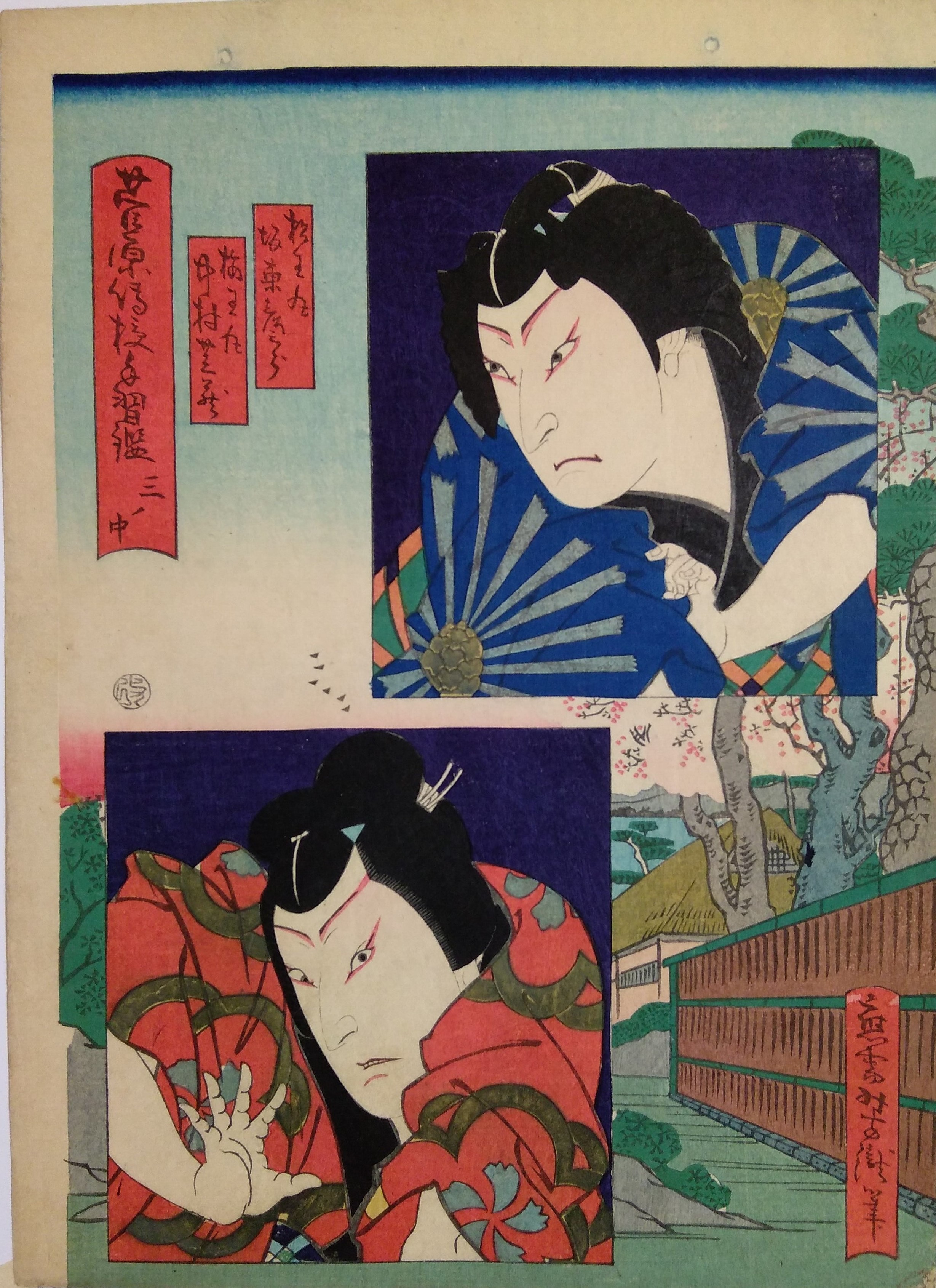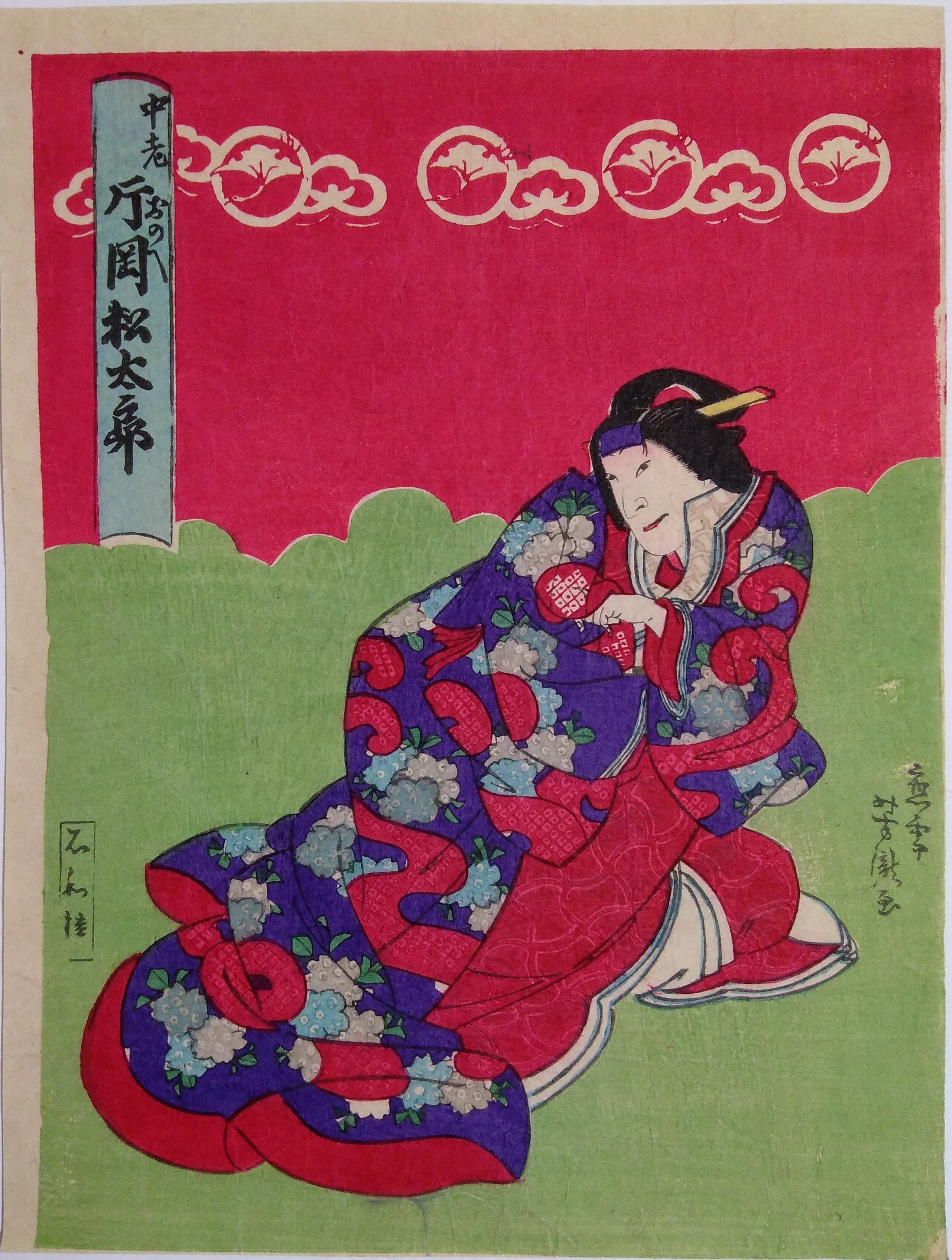Utagawa Yoshitaki
1841 ~ 1899Utagawa Yoshitaki, active from the late 1850s to the late 1880s, was a prolific artist who likely studied as a pupil of Utagawa Yoshiume in both Edo and
Ōsaka where he spent most of his time being particularly influenced by the works of Hirosada.
Starting his career in his early twenties, Yoshitaki published hundreds of works, primarily in chūban format and focusing on yakusha-e (actor prints), but also other genres
such as bijin-ga (images of beautiful women), musha-e (warrior prints), and fūkei-ga (landscapes), sometimes in deluxe ōban editions.

Meiji
The actors Nakamura Shibazō and Bandō Hikosaburō are playing the roles of Matsuōmaru and Umeōmaru in a scene from the third act of the drama Sugawara and the Secrets of Calligraphy (Sugawara Denju Tenarai Kagami: san no naka, 菅原伝授手習鑑: 三ノ中).
Along with Kanadehon Chūshingura, this play is one of the most popular dramas in the kabuki repertoire.
The actors Nakamura Shibazō and Bandō Hikosaburō are playing the roles of Matsuōmaru and Umeōmaru in a scene from the third act of the drama Sugawara and the Secrets of Calligraphy (Sugawara Denju Tenarai Kagami: san no naka, 菅原伝授手習鑑: 三ノ中).
Along with Kanadehon Chūshingura, this play is one of the most popular dramas in the kabuki repertoire.
The story is inspired by the life of Sugawara no Michizane (菅原道真), a Heian-era court noble falsely accused of conspiracy and later exiled to Kyūshū. In this play, the fictional triplets Matsuōmaru, Umeōmaru, and their brother Sakuramaru play significant roles,
embodying loyalty and service to Michizane.
Mica painting has been applied to the actors hair and garments, creating a shimmering effect when viewed in backlight. The censor`s seal is visible on the left side.
USD$ 177.00

Meiji
The kabuki actor Onoe Tamizō plays the role of Sagizaka Bannai, a male character from the Chūshingura, better known as the 47 rōnin drama. It belong to a triptych depicting the last scene from the drama`s third act.
USD$ 99.00

Meiji
The kabuki actor Kataoka Matsutarō portrays the onnagata (a male actor in a female role) character Chūrō Onoe, from what appears to be a kabuki play titled
"Kagami yama".
The kabuki actor Kataoka Matsutarō portrays the onnagata (a male actor in a female role) character Chūrō Onoe, from what appears to be a kabuki play titled
"Kagami yama".
This print may be part of a larger series, such as a diptych or triptych, which were commonly produced in Yoshitaki`s works.
In the blue cartouche in the top left corner, the names of the actor and character are displayed. The publisher`s mark is located in the bottom left corner, while the artist`s signature,
Yoshitaki, is on the opposite side.
USD$ 79.00
 Sold Out
Sold Out
Meiji
The kabuki actor Arashi Rikan playing the role of a warrior.
The kabuki actor Arashi Rikan playing the role of a warrior.
Hyōmenzuri (表面摺り), the technique of rubbing the front side of the print with the baren has been used for enriching the aspect of this print. It gives a lacquered-like
effect that can be observed backlight.

Meiji
This Japanese woodblock print diptych vividly captures a scene from kabuki a theater drama, featuring two actors in elaborate traditional costumes. On the right, the actor Jitsukawa Enjaku I portrays Tsunayoshi, seated in a dignified pose with a focused expression.
His costume is richly decorated in blue and green tones, adorned with intricate patterns that convey his noble character. On the left, Nakamura Fukusuke III plays Osame no Kata, shown in a more dynamic pose as she leans forward, holding a fan, dressed in a vibrant red kimono
patterned with floral and geometric motifs. The background and props, such as the traditional Japanese screens and pine tree, enhance the historical and cultural setting of the play, emphasizing the artistry and attention to detail characteristic of ukiyo-e prints from this era.
